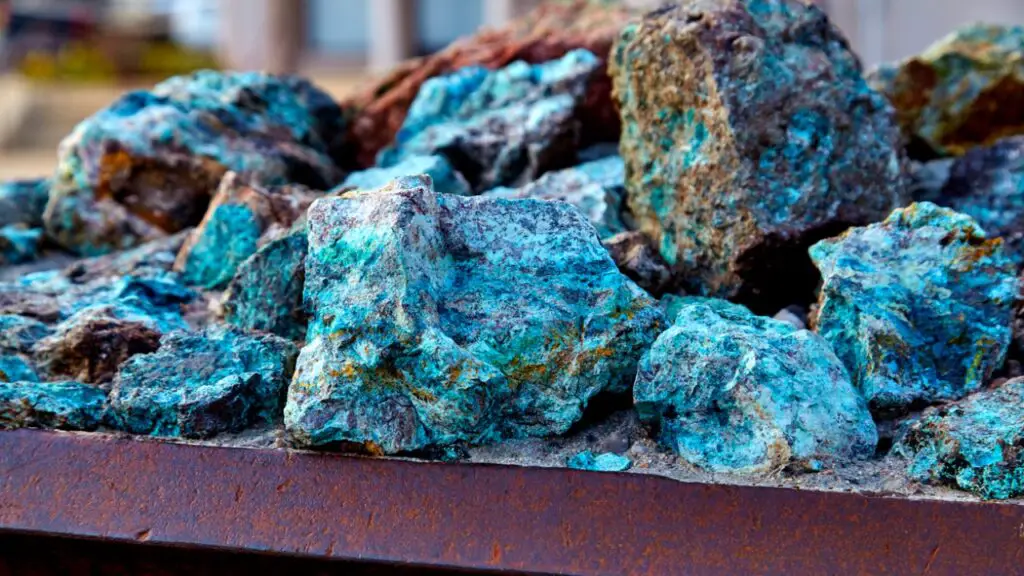The rapid snowballing of Africa’s rare earths metal production is set to become the world’s alternative source in 2023 and beyond, as global demand surges and world powers seek to wean off their dependence on China amid a new geopolitical multipolar world order. Africa’s vast reserves of rare earth metals have come under the radar of world powers fueled by the devastation emanating from the climate change crisis and calls for a drastic reduction in the growth and operations of extractive industries.
Furthermore, the race to net-zero emissions compounded by increased climate-induced natural disasters has intensified the green energy transition, instigating another scramble for Africa’s resources rare earth metals are at the heart of the race to green energy as well as providing opportunities for massive economic growth by injecting much-needed revenues to finance core socio-economic objectives in the continent.
Rare earth elements (REEs) refers to a group of 17 metals that have proven invaluable to both human and national security. They include, nickel, manganese, chromium, graphite, lithium, neodymium, samarium, yttrium among others. They are used in the manufacture of electronics such as computers, smart phones, digital cameras, televisions, fluorescent and light-emitting-diode (LED). By the same token, they are also used in renewable energy technology and national defense such as in satellites, jet engines, GPS equipment, missile guidance, generators for wind turbines, military-grade weaponry, defense systems and other high-level advanced technologies.
Amid the heavy indebtedness, skyrocketing inflation levels and the ominous dollar doom loop affecting most African countries, generated revenues from rare earths are a much-needed boost to economies of producing countries. In tandem, this will aid in poverty alleviation, realization of developmental goals, job creation among a host of other benefits. Besides, the African Continental Free Trade Area (AfCFTA) can prove invaluable in ameliorating value addition, and strengthening global trade partnerships.
As the world accelerates the adoption of the fourth industrial revolution (4IR) technologies, the demand for rare earths elements will explode coupled with the growing urgent needs of green industries. Consequently, REEs have gained a whole new prominence and therefore a constant supply is key to both national security and economic viability of many countries across the globe.
For a long time China has undisputedly dominated the rare earths market, controlling 60 percent of global production and 85 percent of processing capacity. However, with the shifting geopolitical landscape, this dominance has already been challenged. Tensions revolving around China and Taiwan, have resulted in the U.S, Australia, Canada and other countries seeking alternative sources for their rare earth production and processing. A report from the Brookings Institute indicates that currently, China controls most global critical minerals refining, and its upstream control of raw commodities is also increasing. Additionally, China accounts for two-thirds of the world’s aluminium refining and smelting capacity, 80% of global lithium refining capacity, two thirds-of global cobalt refining capacity and more than 80% of global graphite production and mining, according to the US Geological Survey (USGS), The East Asian country controls much of the world’s electric vehicle battery manufacturing.
READ MORE: Africa becoming a global fertilizer production hub
China is also the leading manufacturer of wind turbines, solar panels, energy storage, and electric transmission, among other applications. Inarguably, the world is highly dependent on sourcing from China to advance the energy transition and meet decarbonization goals. In light of this, the International Energy Agency (IEA) has raised concern over the high concentration of production and processing operations in China for the energy transition. This has also driven the global scramble for Africa’s rare earths, which is only beginning.
Africa’s rare earths market has colossal potential as the continent is endowed with the largest mineral reserves in the world, which remain largely untapped. DRC has 50% of the world’s cobalt, South Africa has 91% of the world’s platinum, 46% of its yttrium, 22% of its manganese, 35% of its chromium and 16% of its vanadium. Morocco has 70% of the world’s phosphate reserves. Gabon has up to 15% of the world’s manganese while Zimbabwe has vast reserves of lithium together with Nigeria and Namibia. Africa’s untapped potential in rare earths exploration is largely attributed to the sector being considered as a non-priority sector compared to gold, diamond and other precious metals.
According to the Natural Resource Governance Institute (NRGI) Triple Win report, Africa has at least a fifth of the world’s reserves in a myriad of minerals that are vital for the world’s energy transition. These ‘transition metals’ will play a pivotal role in the decarbonization race which is driving the growing demand. With perspective to the World Bank’s findings on clean energy production needed to keep global heating below 2°C by mid-century, production of graphite, lithium, and cobalt will need to be ramped up to 3.1B tons by 2050, up more than 450% from 2019 levels, to meet demand from energy and energy storage technologies. Global demand for rare earths reached 125,000 metric tons and is forecast to reach 315,000 tons by 2030. Countries like South Africa, Madagascar, Malawi, Kenya, Namibia, Mozambique, Tanzania, Zambia, and Burundi have significant quantities of neodymium, praseodymium, and dysprosium.
Photo/ISPI
How can Africa Monetize this Opportunity?
Indeed, Africa can fully exploit this golden chance to mint a plethora of gains from rare earths production, but countries have to tread with caution to ensure they maximize on the benefits. African countries have to tread carefully fully aware of the predatory and somewhat non-symbiotic relationship with Western countries in regards to extractive industries where value has often been shipped abroad as opposed to being retained at home. Through multinational corporations (MNCs), these powers have continued to retrieve raw materials from African countries for years, only for the continent to import the finished products. This has greatly retrogressed development and the local populace has been robbed off the opportunity to fully benefit from their motherland resources, reinstating the continent’s status as ‘resource cursed.’ African citizens should benefit from the wealth and dividends produced by this new frontier.
ALSO READ:OPEC+ oil cuts mixed bag of fortunes for African economies
Africa needs to take strategic steps to secure its own national and economic interests, because having vast reserves does not translate to successful exploitation and prosperity. The continent’s growth trajectory is contingent upon its response to this rare earths’ demand. Its critical for Africa to build its capacity to locally manufacture finished products, in cognizance of their environmental impact. Africa should capitalize on regional co-operation by building strong trade partnerships, maximizing AfCFTA to bolster country’s value addition capabilities within the bloc before exporting.
However, there has been a change in tide evidenced by the actions of several African countries’ refusal to grant mining rights to MNC’s unless they meet certain conditions. This was distinctly highlighted in the last quarter of 2022, when in an effort to increase value addition, Nigeria turned down Tesla Inc’s request to mine lithium and instead, asked the company to set up a battery industry in the West African country. Nigeria’s Minister of Mines, Olamilekan Adegbite then looked to Australia in a move to find lithium miners, who better align with Nigeria’s industrial policy. According to the World Bank, lithium is projected to triple in demand by 2040. Since 2020, the price per tonne of lithium jumped from about $6000 to over $78,000 in 2022. Nigeria is poised to mint billions by exploring and pursuing value addition options from its lithium resources.
In the same vein, Zimbabwe, which holds some of the world’s largest reserves of hard rock lithium, recently banned lithium exports opting instead, to manufacture batteries within the continent rather than just exporting the raw materials. The government cited concern that it was losing 1.7 billion euros from exporting it as a raw mineral and not processing it into batteries in the country. The government noted that foreign companies and smugglers have been extracting the valuable ore without paying the required dues.
Zimbabwe’s government hopes to cover 20 per cent of global demand with lithium deposits in the future as it boasts the largest amount of the mineral in Africa and has enough of it to supply a fifth of the world’s needs. Like many other mineral-rich African states, it has allowed its raw minerals to be extracted by multinationals for decades, without developing local industries that could process them which in turn could create employment especially for the youth. Whilst it’s on track to become one of the world’s largest lithium exporter, the government emphasizes that the country should start its own battery industry, rather than allowing foreign companies to dominate battery production.
Some of the existing projects include the Songwe Hill rare-earths mine in Malawi expected to go into production in 2025. A Canadian company invested $277.4M and anticipates to recover it in two and a half-years of operation. A total of $2.2B is expected to be generated in cash flow over the mine’s estimated 18-year life. Into the bargain, Australia’s Bannerman Energy announced that it had acquired a 41.8% stake in Namibia Critical Metals, which owns 95% of the Lofdal rare-earths project in Namibia, for $4.8B. The deal was done via a share swap with South Africa’s Philco Systems and Britain’s Adventure Resources Holdings.
In 2020 Angolan President João Lourenço granted exclusive mining rights for 35 years to the Longonjo mine, which produces neodymium and praseodymium, among other rare-earth elements to Ozango Minerais, the Angolan subsidiary of the British company Pensana Rare Earths. The prospects are huge for the British group, which is planning a total investment of $494m over the entire chain, and said in March that it expected annual revenues of more than $970m. Although the rare earth metal will be mined in Angola, the processing plant where most of the added value will be created will be located in Hull, Yorkshire, England. According to the agreement signed with Angola, the country will receive a mining royalty corresponding to 2% of the mine’s revenues, in addition to national and municipal taxes. The British company will be exempt from these taxes during the first two years of operation and have also obtained complete exemption from customs duties on imported equipment. The Steenkamskraal Mine in South Africa boasts one of the highest grades of rare earths elements in the world containing 15 elements and 86,900 tons of total rare earth oxides, with large deposits of neodymium and praseodymium.
African producing countries need to ensure that value is captured and more of it retained in the continent amid negotiations over royalties and investments. Mitigating environmental risks will also be integral given Africa’s vulnerability to effects of climate change.




